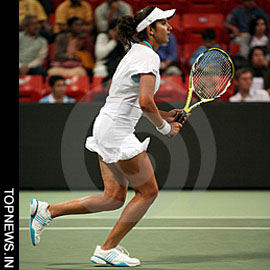Islam sets limits on sensuality of female tennis
 Doha - Silhouettes instead of photographs, and computer manipulation to conceal thighs: that is how Qatar promoted this week's season-ending WTA Championship.
Doha - Silhouettes instead of photographs, and computer manipulation to conceal thighs: that is how Qatar promoted this week's season-ending WTA Championship.
For years the WTA has appealed to sensuality to sell its stars, but the first experience of a Masters tournament in the Middle East left it with no alternative but to moderate its presentations.
The tournament that brings together the season's eight best female tennis players arrived in Qatar shortly after the end of the Ramadan, the month of religious observance in which Muslims fast and generally abstain from worldly activities to meditate and get closer to God.
Qatar, which has experienced an opening to Western culture over the past few years, understood that change cannot happen overnight. So on the streets there is no sign of the WTA's classic advertising posters, showing off the beauty of Serbia's Ana Ivanovic and company.
"Since it was the month of Ramadan, we met and we decided that it was better to have silhouettes and not to show players' legs and arms. We thought we had to adapt to the country and respect its habits and religion," Moroccan Karim Alami, the tournament director, told Deutsche Presse-Agentur dpa.
Tournament organizers had previously sent photographs of the girls wearing tennis clothes to the only advertising agency in Qatar, which is state-owned, and they were rejected.
That is why the tournament seeks to promote itself through posters that only reveal the players' purple silhouettes, with nothing that could be found to have sexual connotations.
"This is their idea," WTA boss Larry Scott told dpa of the decision to run the campaign in this way.
The decision deprived the most visible angles of the Khalifa Tennis Centre, in which the tournament is played, of the photos of stars in mini skirts.
Some media went even further: just a few days ago, after the end of Ramadan, both The Peninsula - an English-language newspaper - and the Alarab - which is written in Arabic - changed media releases, which do show the players in tennis clothes, and used a computer to paint over them black leggings that concealed their thighs.
Around town, women wear wide black tunics to their ankles, which also cover their heads. Some let their faces show, while a few just let their eyes be seen and a minority appear completely covered.
"Those who cover themselves the most are most likely from Qatar and are not young. Young women are more open," said Hassan, a local salesman.
The WTA believes it could contribute to Qatar's opening.
"I'm firmly convinced that bringing women to play here we're going to help. We are going to bring an empowering message for young girls, not just in Doha, in the region, that girls can have the same opportunities as men," a convinced Scott said.
He added that Qatar wants to show the world that it is "progressive" by hosting such an important women's tournament.
Serbian world number one Jelena Jankovic was also eager to make a contribution with her presence to the fate of women in the Middle East.
"I hope we can be a good influence for the change, for the women here," she said.
Beyond good intentions, there is obviously business. The WTA is busy with the expansion of its product. It needs to open borders and enter new markets, a good enough reason to take the Masters to the small peninsula on the Persian Gulf until 2010.
"Tennis is very strong in Europe. It's kind of our big support. The Middle East, India are really the future," said the boss of women's tennis.
Doha rises in the horizon like a luxurious and futuristic oasis of metal and mirrored glass. Piles of rubble, cranes, huge construction sites and dust are everywhere - the future is coming, but it is not quite there yet.
Just like the full liberalization of women. (dpa)